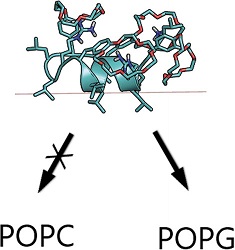SUPRAMOLECULAR CHEMISTRY, 2019, 31, 159–171
Crown ether modified peptide interactions with model membranes
Pierre-Alexandre Paquet-CÔtÉ, Matthieu Fillion, Marie-Ève Provencher, FranÇois Otis, Justine Dionne, SÉbastien Cardinal, Barbara Collignon, Jochen BÜrck, Patrick LagÜe, Anne S. Ulrich, MichÈle AugeR, Normand Voyer

Abstract
A simple model of an uncharged antimicrobial peptide, carrying four crown ether side chains, is modified further by the selective incorporation of arginine side chains to control its secondary structure and its interaction with model membranes and living cells. Conformational studies show that shifting the position of a cationic residue in the peptide sequence allows to control its secondary structure and supramolecular self-assembly in solution. Results also demonstrate that the secondary structure influences the interaction with model membranes and cells. An α-helical peptide with greater amphiphilicity forms assemblies that interact with both prokaryotic and eukaryotic model membranes and cells. However, a β-stranded peptide with evenly distributed charges generates assemblies that interact more selectively with prokaryotic model membranes and cells. In addition, we observed differences in peptide orientation between uncharged and cationic α-helical peptides with different phospholipid bilayers. In general, the studied peptides have a higher affinity for thinner membranes, and cationic peptides interacted better with anionic membranes
